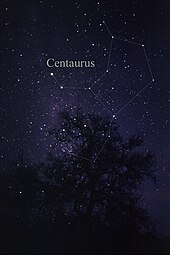Nomenclature

α Centauri (Latinised to Alpha Centauri) is the system's designation given by Johann Bayer in 1603. It bears the traditional name Rigil Kentaurus, which is a Latinisation of the Arabic name رِجْل القِنْطورُس Rijl al-Qinṭūrus, meaning 'the Foot of the Centaur'. The name is frequently abbreviated to Rigil Kent or even Rigil, though the latter name is better known for Beta Orionis (Rigel).
An alternative name found in European sources, Toliman, is an approximation of the Arabic الظَّلِيمَان aẓ-Ẓalīmān (in older transcription, aṭ-Ṭhalīmān), meaning 'the (two male) Ostriches', an appellation Zakariya al-Qazwini had applied to Lambda and Mu Sagittarii, also in the southern hemisphere.
A third name that has been applied is Bungula (/ˈbʌŋɡjuːlə/), of obscure origin. Allen can only surmise it may have been coined from the Greek letter beta (β) and Latin ungula 'hoof'.
Alpha Centauri C was discovered in 1915 by Robert T. A. Innes, who suggested that it be named Proxima Centaurus, from Latin 'the nearest star of Centaurus'. The name Proxima Centauri later became more widely used and is now listed by the IAU as the approved proper name.
In 2016, the Working Group on Star Names of the International Astronomical Union (IAU), having decided to attribute proper names to individual component stars rather than to multiple systems, approved the name Rigil Kentaurus (/ˈraɪdʒəl kɛnˈtɔːrəs/) as being restricted to Alpha Centauri A and the name Proxima Centauri (/ˈprɒksɪmə sɛnˈtɔːraɪ/) for Alpha Centauri C. On 10 August 2018, the IAU approved the name Toliman (/ˈtɒlɪmæn/) for Alpha Centauri B.
Comments
Post a Comment